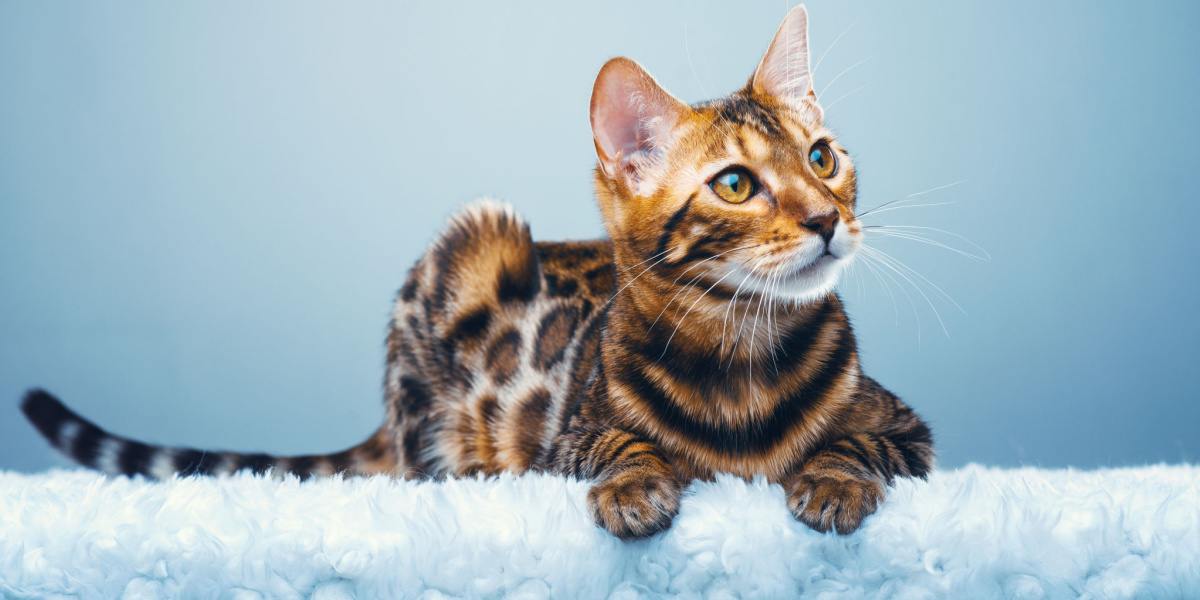
Hybrid cat breeds are created by cross-breeding domestic cats with small wild cats. Using wild cat blood typically happens very early in the breed’s development and is abandoned once the breed type is established, at which point only domestic cats are used for breeding.
Hybrid cat breeds are great for people who love the exotic look of wild cats but know that it’s best to only keep domestic cats as pets. For the most part, hybrid cats act just like normal cats and are bred with an emphasis on friendliness and sociability toward people.
All of the hybrids listed below are fully established breeds accepted by The International Cat Association, which is an international all-breed cat registry. These breeds are far removed from their wild relatives and are considered domestic cats.
If you like the exotic look of big cats like tigers, jaguars, and lions, or smaller wild cats like cheetahs, servals, leopard cats, and jungle cats, then these hybrid breeds will be right up your alley.
#1 Bengal
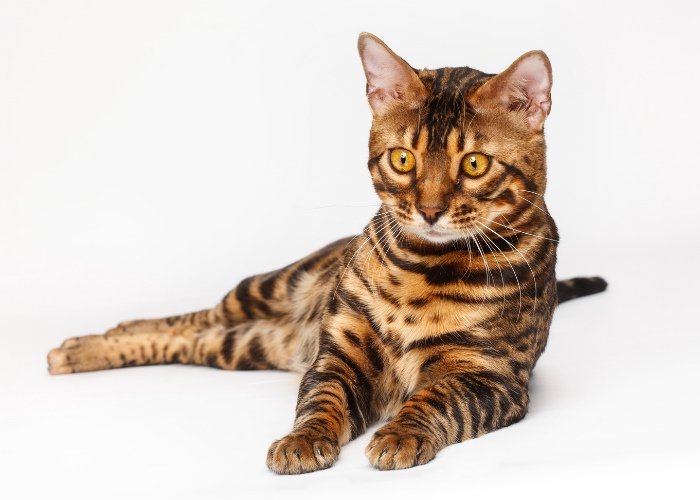
The Bengal was developed by breeding domestic cats with the Asian leopard cat (Prionailurus bengalensis). The founder of the breed, Jean S. Mill, first experimented with crossing a domestic cat with the Asian leopard cat in the 1960s.
Two decades later, Mill again set out to create a wild-looking cat with a docile personality, and the result was the beginning of the modern Bengal breed. TICA accepted the Bengal as a new breed in 1986, and the breed was granted championship status in 1991.
The Bengal’s dense, luxurious and close-lying coat is soft and silky. The coat comes in two lengths: shorthair (short to medium) and longhair (medium to long, with furnishings). Some Bengals have “glitter,” a term used to describe a certain type of hair that reflects light and makes the cat look as though it has been sprinkled with glitter.
Bengals may be spotted, marbled, charcoal spotted, or charcoal marbled. Some Bengal coats feature special spots called rosettes, which resemble the markings seen on leopards, jaguars, and ocelots.
Bengals are an athletic and energetic breed that loves to climb, run, pounce, and play. They are happiest when they get a lot of mental stimulation and exercise. Some Bengal owners even use cat running wheels to help them get enough physical exercise. In temperament, Bengals are outgoing, curious, and affectionate, but they are often too busy to want to lounge in your lap.
Also Read: 5 Things You Didn’t Know About The Cashmere Bengal Cat
#2 Chausie

The Chausie (pronounced chow-see) looks a lot like a miniature cougar. This hybrid breed was developed in the 1990s when a collaboration of breeders crossed a small, wild cat called the jungle cat (Felis chaus) with domestic cats. The jungle cat itself looks a lot like a domestic cat, being small in size with moderate features. After its development, the Chausie cat was granted foundation registration status with TICA in 1995, and given championship status in 2013.
The Chausie has a short to medium, slightly coarse double coat that comes in three color patterns: brown ticked tabby, sandy and reddish-brown, or gray that looks a lot like the caracal’s coat. Some Chausies are solid black or black grizzled ticked tabby, which is a unique color pattern inherited directly from the breed’s wild ancestor, the jungle cat.
Like the Bengal, the Chausie is extremely active and energetic. This breed is go, go, go all the time. Their curiosity and energy drive Chausies to explore, which can lead to them opening cabinets and strewing the contents all around. This breed needs lots of interactive playtime and attention from its people.
The Chausie does not do well if left alone for many hours a day. They form close bonds with their human family (adults and older children are best for this breed) and will doll out plenty of affection.
#3 Pixie-Bob

The Pixie-Bob was rumored to have been created with a bobcat hybrid cat and a domestic cat. However, there is no evidence that the Pixie-Bob contains any bobcat blood, or any wild blood at all, for that matter.
For now, the jury is still out on whether this breed is truly a hybrid or is completely domestic, but the Pixie-Bob is affectionate, active, sociable, and has been described as doglike. Its thick double-coat is patterned in brown spotted tabby, and the Pixie-Bob often has lynx tips on the ears. It always has a naturally bobbed tail.
The founder of the Pixie-Bob breed, Carol Ann Brewer, rescued a very tall classic patterned male with a short tail in the 1980s. This cat was bred with a neighbor’s domestic female, and Brewer adopted a female kitten from the litter. This kitten, who was named Pixie, looked wild, with a spotted, red-fawn-colored coat and a bobtail.
Enamored, she set about to create a breed with this distinctive appearance. TICA accepted the Pixie-Bob for Exhibition Status in 1994; it was granted championship status in 1997.
Also Read: Toybob: Small Cats With Big Loving Hearts
#4 Savannah
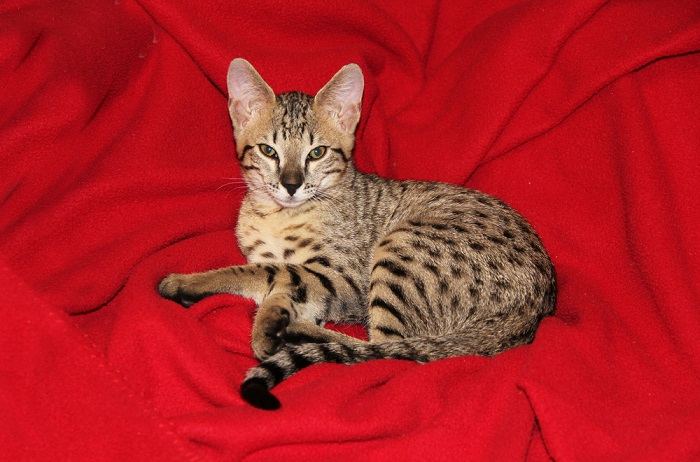
The Savannah cat was developed by crossing domestic cats with the serval (Leptailurus serval), a small wild cat native to Africa that has a slender body, small head, and large ears. The breed had its beginnings in 1986 when a female domestic cat gave birth to a kitten sired by an African serval.
This first-generation hybrid cross (F1) kitten, named Savannah, inherited traits from both her domestic mother and serval father. Patrick Kelly and Joyce Sroufe worked together to create a new breed, the Savannah, which was accepted for registration by TICA in 2001, and achieved championship status in 2012.
Like the serval, the Savannah is tall and lean with a long neck, large ears, and a boldly spotted coat. This breed is curious, outgoing, and assertive. Unusual for most cats, the Savannah enjoys playing in the water. Like other hybrid breeds, the Savannah needs a lot of exercise and mental stimulation to be happy. They are engaging pets that will steal your hearts like no other cat.
Also Read: 80 Unique Names for Savannah Cats
#5 Serengeti
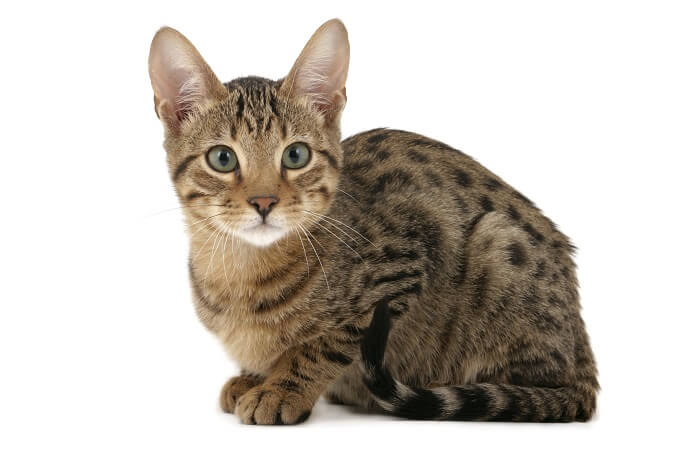
Whereas the Savannah was created using the African serval, the Serengeti was developed to look like the wild African serval, but without using any serval blood. Instead, the Serengeti was developed using Bengals and Oriental Shorthairs. This means the Serengeti has a very small amount of wild cat blood, inherited from Bengal, which itself was created using the wild Asian leopard cat.
The breed founder, Karen Sausman of California, started work developing the Serengeti in 1995, and today the breed is found throughout the United States, United Kingdom, Europe, Australia, and other parts of the world. The Serengeti is an Advanced New Breed, which means it is eligible to be shown in TICA-sanctioned shows but does not earn titles or points.
The Serengeti has long legs, a long neck, and large ears. The short, silky coat comes in brown tabby, solid black, and silver/smoke. Confident, friendly, and vocal, Serengeti cats are extremely active and like to run, climb, and play.
Also Read: 12 Rare Coat Colors and Patterns In Cats
#6 Toyger

Created to look just like a miniature tiger, the Toyger has surprisingly little wild cat blood. The breed was initially developed using a domestic cat, a Bengal, and a street cat from India. The very small amount of wild cat blood in the Toyger comes from the Bengal, which was created using the Asian leopard cat.
The key to creating the Toyger’s distinctive tiger-striped pattern was the mackerel tabby pattern found in many cats. A cat breeder named Judy Sugden tried to improve the clarity of mackerel tabby markings when she realized one of her Bengal cats had two spots of tabby markings on his head. She bred this Bengal cat and a striped domestic shorthair, and the Toyger was on its way.
The Toyger’s beautiful coat displays a bold, vertical striped pattern and circular markings on the head similar to those found on a tiger. The breed even has a unique, rolling gait reminiscent of a real tiger strolling through the savanna. Friendly to people and other pets, the Toyger is laid-back, intelligent, and very interactive.
Also Read: 8 Purrfect Cat Breeds With Stripes
Non-Hybrid Cat Breeds That Look Wild
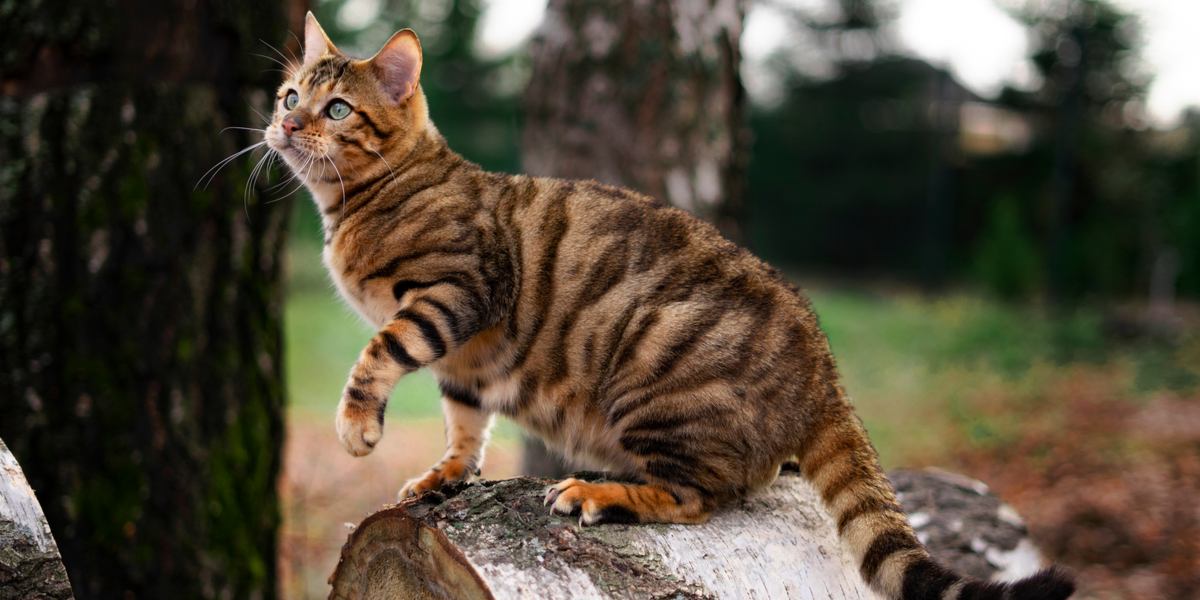
For cat lovers who want a pet that looks like it just stepped out of the jungle, there is no shortage of wonderful breeds to explore. In addition to the hybrid breeds, the Bengal, Chausie, Pixie-Bob, Savannah, Serengeti, and Toyger, some other breeds look like wild animals but are 100% domestic. The black Bombay looks like a panther, but it was created using the Burmese and black American Shorthair.
The Abyssinian looks very exotic and wild, but it is a fully domestic breed. With its spotted coat, you might think the Ocicat had wild blood, but this breed was created from Abyssinians, Siamese cats, and American Shorthairs. The Egyptian Mau, with its silvery spotted coat, looks like an exotic cat but has no wild cat blood in its ancestry.
Also Read: 7 Similarities Between Domesticated Cats And Big Cats
Frequently Asked Questions
What is a hybrid cat breed?
A hybrid cat breed is one that is developed using a small wild cat species and domestic cat breeds. Some small wild cats that have been used to create hybrid cat breeds include the African serval, the Asian leopard cat, and the jungle cat. Some established hybrid cat breeds include the Bengal, Chausie, Savannah, Serengeti, and Toyger.
Although the Pixie-Bob looks like a miniature bobcat, and is rumored to have been created with a bobcat hybrid cat and a domestic cat, this has never been proven so no one can say for sure whether the Pixie-Bob is a true hybrid cat breed. Another hybrid cat breed, called the Cheetoh, was created by crossbreeding Bengal cats and Ocicats. The Cheetoh cat is not fully established and is not currently accepted by any cat breed registry.
What is the biggest hybrid cat?
The largest hybrid cat breed is the Savannah. Although Savannah range in size, a fully grown male Savannah can weigh up to 20 pounds.
Do hybrid cats make good pets?
Hybrid cats like the Bengal, Chausie, Pixie-Bob, Savannah, Serengeti, and Toyger make excellent pets because they have been bred to look wild but to act friendly and affectionate with people. Hybrid cat breeds are just like regular house cats in every way, including litter box habits and nutritional and vaccination needs.
Different hybrid cat breeds have slightly different personalities, but most hybrid breeds enjoy the company of people and prefer not to be left alone for long periods of time. Most hybrid cats are very active and energetic, loving to climb, run, jump, and play. Due to the highly active and energetic natures of some hybrid cat breeds, certain breeds are recommended for households with adults only, or families with older children.



